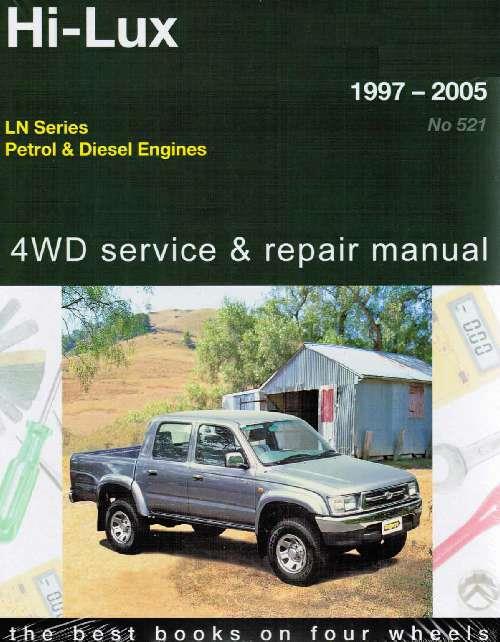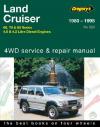Toyota Hi-Lux LN Petrol and Diesel l 1997-2005 repair manual NEW
Toyota Hi-Lux LN 4WD Gregorys Service and Repair Manual 1997-2005NEW - softcover 310 pagesOther Toyota Car Repair Manuals click hereGet other Toyota Hi-Lux and 4Runner manuals click hereToyota Hi-Lux 2WD & 4WD LN Series Petrol & Diesel 1997 - 2005 Gregorys Owners Service & Repair Manual covers the LN series . Engines (petrol): Engines (diesel): Transmissions: Gregory's 4x4 Service & Repair Manuals are based on Australian (RHD) right-hand-drive models and contain hundreds of photographs and illustrations that support step by step instructions for repair and maintenance procedures. It offers excellent value for money with all instructions based on a full vehicle stripdown. It also identifies which jobs are better left to the professional. Benefits:
Everything you need to know:
Information you can trust:
Contents:
|
The Toyota Hilux and Toyota Tacoma are a series of compact pickup trucks produced and marketed by the Toyota Motor Corporation. The Hilux name was adopted as a replacement for the Stout in 1969, and remains in use worldwide. In North America, the Hilux name was briefly retired in 1976 in favor of Truck, Pickup Truck, or Compact Truck, until it was renamed Tacoma in 1995. One popular option package, SR5 (Sport Rally 5-Speed), also became synonymous with the truck, even though the option package was also used on other Toyota models as well. In 1984, the Trekker, the camper version of the Hilux, was changed to the 4Runner in Australia and North America, and as the Hilux Surf in Japan. The 4Runner is now a full SUV, and the more recent models do not resemble the Tacoma.
First generation
The Hilux started production in March 1968 as the RN10 in short wheelbase form with a 1.5 L engine. This was upgraded to a 1.6 L I4 engine in February 1971.
Global markets:
* 1968-1971 - 1.5 L (1490 cc) 2R I4
In April 1969, a long wheelbase version was added to the range. The short wheelbase version also continued in production for many more years.
In spite of the name "Hilux", it was a highly-luxurious vehicle only when compared to the Stout. Hilux was engineered and assembled by Hino Motors to augment the Hino Briska, Briska and Stout or to replace them in some markets. For the North American market, the only body style was a regular cab short bed and all were rear-wheel drive. It used a typical truck setup of A-arms and coil springs in front and a live axle with leaf springs in back. A 4-speed manual transmission was standard.
Global markets:
* 1968-1971 - 1.5 L (1490 cc) 2R I4[1]
* 1971-1972 - 1.6 L (1587 cc) 12R I4[1]
Second generation
In the middle of 1972, the 1973 Hilux was released as the RN20. A more comfortable interior was specified along with exterior updates.
Global markets:
* 1972-1978 - 1.6 L (1587 cc) 12R I4[1]
* 1977-1978 - 2.0 L (1968 cc) 18R I4[1]
Engine:
* 1975-1980 - 2.2 L (2189 cc) 20R SOHC I4, 96 hp (72 kW)
Third generation
In North America the Hilux saw the use of four wheel drive. It had a solid front axle and leaf suspension. The body saw a redesign that included single round headlights and a less complex body. These trucks became known as first generation 4WDs. It was the first Hilux with automatic transmission.
Research and development work on the Trekker lead to the development of the 4Runner, which was released in 1984. The 4Runner was sold in Australia, North America and the United Kingdom; in some other markets, such as Japan, it was called the Hilux Surf.
Engines:
* 1981-1983-2.4 L(2366 cc) 22R SOHC I4, 96 hp (72 kW) at 4800 rpm and 129 ft·lbf (175 N·m) of torque at 2800 rpm.
* 1981-1983-2.2 L Diesel I4, 62 hp (46 kW) at 4200 rpm and 93 ft·lbf (126 N·m) of torque (SR5 long bed only).
* 1981-1983-1.8 L preflow 4 speed manual (Australia)
Fourth generation
The 1984 redesign introduced the Xtracab two-row extended cab option. There was also a fuel injected model, the 22R-E. Two diesel engines were also offered, the 2L and the turbocharged 2L-T. The diesels were discontinued in the U.S. after the 1986 model year, this was due to higher performance expectations from customers and the wide availability of inexpensive gasoline. The next year saw the introduction of a turbocharged option, the 22R-TE. The solid front axle was swapped out for an independent front suspension/torsion bar setup in the 4x4 model in 1986, and optional automatic front locking hubs and an electronic transfer case was added as well. A V6 engine was introduced in 1988.
Toyota introduced a new generation of the Hilux in most markets in late 1988 but the fourth generation remained in production until 1997 in South Africa. Toyota says this was due to South African "content laws" and thus it was cheaper to continue to produce the fourth generation Hilux, rather than retool the plant for the fifth generation.
Engines:
* 1984-1988 - 2.4 L (2366 cc) 22R SOHC I4, 96 hp (72 kW) at 4800 rpm and 129 ft·lbf (174 N·m) at 2800 rpm
* 1984-1986 2.2 L 1L (2188 cc)Diesel I4, 62 hp (46.2 kW) at 4200 rpm and 93 ft·lbf (126 N·m) (SR5 long bed only)
* 1984-1985 - 2.4L (2446 cc) Diesel I4 2L SOHC, 83 hp (62 kW) at 4200 rpm and 122 ft·lbf (165 N·m) at 2400 rpm;
* 2L-T (2446 cc) SOHC, 92 hp (69 kW) at 4000 rpm and 159 ft·lbf (216 N·m) at 2400 rpm
* 1984-1988 - 2.4 L (2366 cc) 22R-E SOHC FI I4, 112 hp (78 kW) at 4800 rpm and 137 ft·lbf (185 N·m) at 2800 rpm
* 1986-1987 - 2.4 L (2366 cc) 22R-TE SOHC FI turbo I4, 135 hp (101 kW) at 4800 rpm and 173 ft·lbf (234 N·m) at 2800 rpm
* 1988 - 3.0 L 3VZ-E V6, 145 hp (112 kW) @ 4800 rpm; 180 ft·lbf @ 3400 rpm
1984–1988 Toyota Pickup (US)
1984–1988 Toyota Hilux (LN56R) 2.4D 4-door utility (Australia)
Fifth generation
The next redesign, in 1988, saw a longer-wheelbase option, 122 in (309.9 cm) versus 103 in (261.6 cm) for the regular wheelbase. One-piece cargo box walls eliminated the rust-prone seams found in earlier models. The V6 Xtracab SR5 earned Motor Trend magazine's Truck of the Year award that year. Production began at the NUMMI plant in Fremont, California, USA in 1991.
The Hilux (Seventh Generation) in South America was produced in Colombia since 1994 to 1998 by SOFASA (Only Petrol engine 2.4 l), sold and export to(Venezuela and Ecuador). For Argentina, Brazil, Uruguay was produced in Argentina since 1997 to 2005 (Zárate Plant. Petrol and Diesel engine). Bolivia, Chile, Paraguay, Peru was imported from Japan since 1989 to 1997 (Petrol and Diesel Engine). South American 7-G Versions:
Toyota Hi-Lux LN 4WD Gregorys Service and Repair Manual 1997-2005 1998 1999 2000 2002 2002 2003 2004 HiLux

 0 Items (Empty)
0 Items (Empty)

.png)
